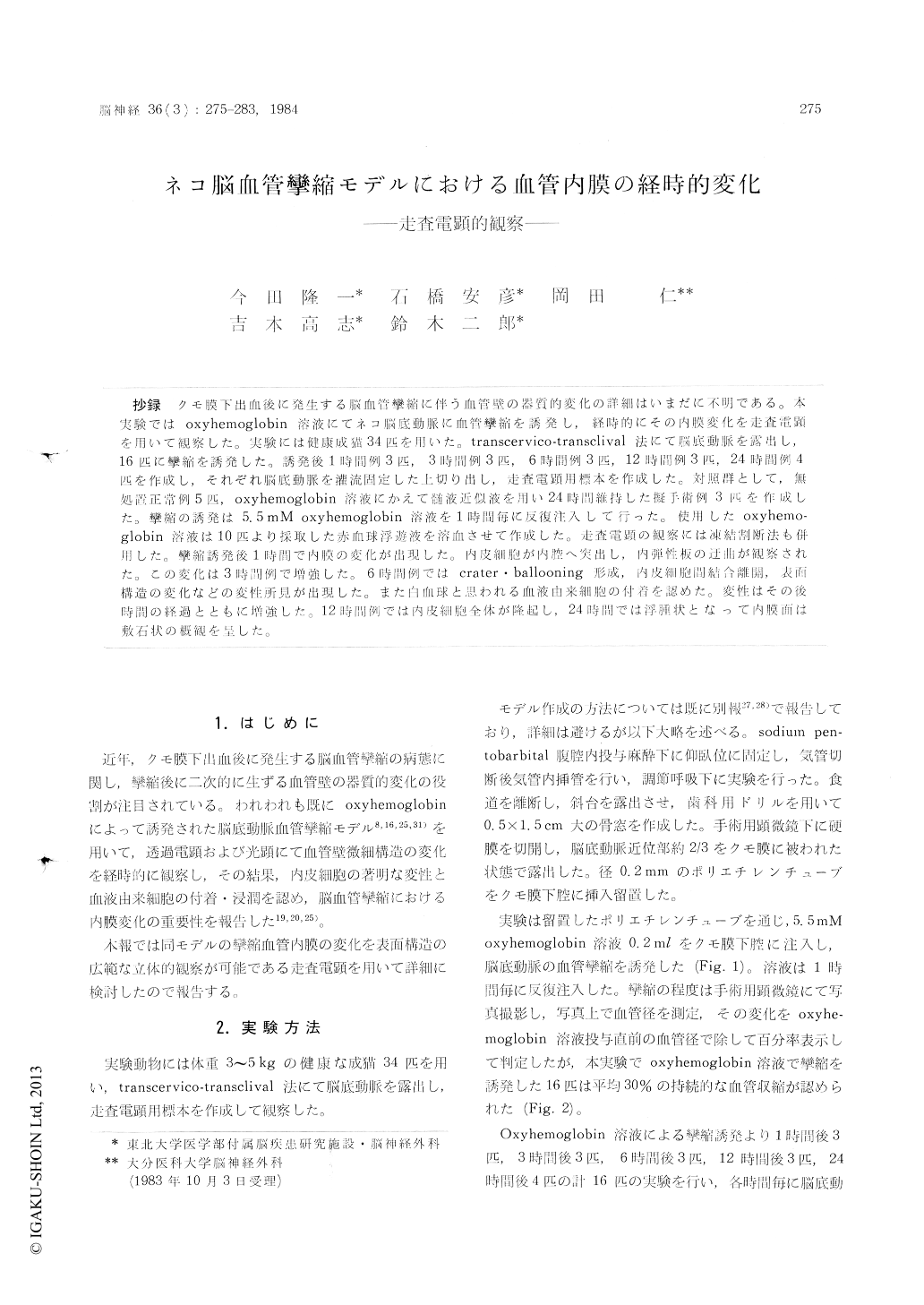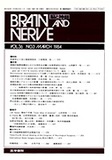Japanese
English
- 有料閲覧
- Abstract 文献概要
- 1ページ目 Look Inside
抄録 クモ膜下出血後に発生する脳血管攣縮に伴う血管壁の器質的変化の詳細はいまだに不明である。本実験ではoxyhemoglobin溶液にてネコ脳民動脈に血管攣縮を誘発し,経時的にその内膜変化を走査電顕を用いて観察した。験には健康成猫34匹を用いた。transcervico-transclival法にて脳底動脈を露出し,16匹に攣縮を誘発した。誘発後1時間例3匹,3時間例3匹,6時間例3匹,12時間例3匹,24時間例4匹を作成し,それぞれ脳底動脈を灌流固定した上切り出し,走査電顕用標本を作成した。対照群として,無処置正常例5匹,oxyhemoglobin溶液にかえて髄液近似液を用い24時間維持した擬手術例3匹を作成した。攣縮の誘発は5.5mM oxyhemogobin溶液を1時間毎に反復注入して行った。使用したoxyhemo—globin溶液は10匹より採取した赤血球浮遊液を溶血させて作成した。走査電顕の観察には凍結割断法も併用した。攣縮誘発後1時間で内膜の変化が出現した。内皮細胞が内腔へ突出し,内弾性板の迂曲が観察された。この変化は3時間例で増強した。6時間例ではcrater・ballooning形成,内皮細胞間結合離開,表面構造の変化などの変性所見が出現した。また白血球と思われる血液由来細胞の付着を認めた。変性はその後時間の経過とともに増強した。12時間例では内皮細胞全体が隆起し,24時間では浮腫状となって内膜面は敷石状の概観を呈した。
Organic changes of vessel wall may play animportant role in the pathophysiology of vaso-spasm after subarachnoid hemorrhage. Sequential changes of intimal ultrastructure in experimental vasospasm induced oxyhemoglobin were investi-gated by scanning electron microscope.
Thirty-four cats were used for this study. The basilar artery was exposed by transcervico-trans-clival approach. Oxyhemoglobin solution was ap-plied under the arachnoid membrane around the artery in 16 cats at hourly intervals. Of 16 cats, 3 were sacrificed at 1 hour after the first applica-tion of the solution, 3 at 3 hours, 3 at 6 hours, 3 at 12 hours, 4 at 24 hours. Three sham-operated cats treated by artificial CSF were used as the control together with 5 untreated normal cats. All procedures were performed under aseptic condition. Perfusion fixation was done. The luminal surface and the cut surface made by freeze-fracture method were investigated by scanning electron microscope. As oxyhemoglobin solution, oxyhemoglobin-rich hemolysate was used and the concentration was 5. 5 mM. By hourly application, continuous vaso-constriction of about 70% of the control diameter was obtained.
In the control, the endothelial cell layer was fiat. The elastic lamina had mild waving, and the luminal surface was smooth.
In 1-and 3-hour groups, the elastic lamina was corrugated and the endothelial cells were protru-ded into the lumen in the depressed portion of corrugation. In 6-and 12-hour groups, degenerative changes of the endothelial cells, crater-formation and ballooning, were seen. Some blood-born cells adhered to the luminal surface in such cases. In 24-hour group, the changes of the endothelial cells became more remarkable. Almost all of the cells were protruded, so that the luminal surface show-ed a cobble-stone appearance. the number of adhered blood-born cells was increased. However, luminal narrowing by thrombus formation or en-dothelial stratification was not observed.

Copyright © 1984, Igaku-Shoin Ltd. All rights reserved.


